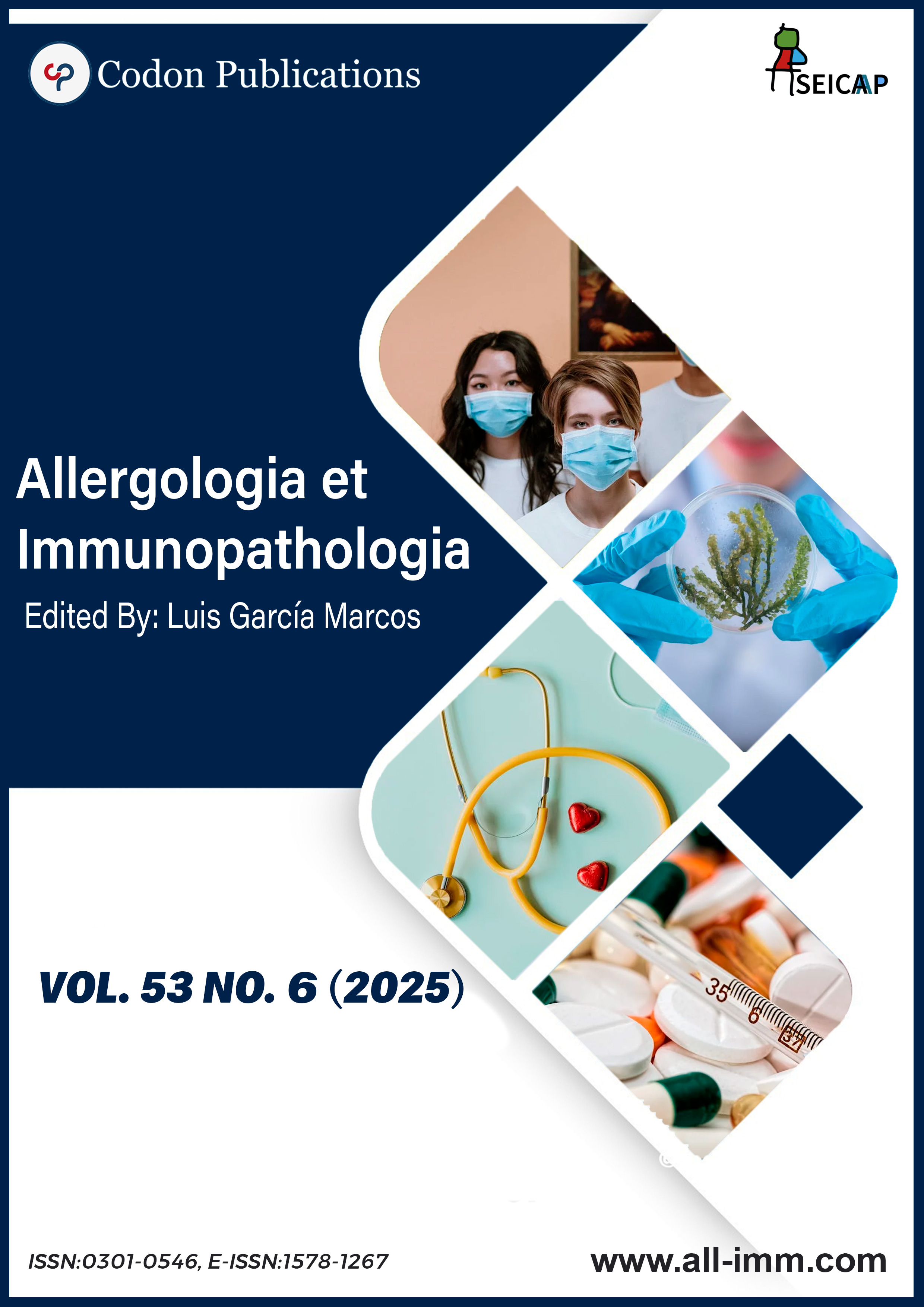Factors associated with disease duration in chronic spontaneous urticaria: A short- to midterm evaluation
Main Article Content
Keywords
antinuclear antibodies, angioedema, basophils, chronic spontaneous urticaria, immunoglobulin E
Abstract
This retrospective study was conducted to identify clinical, demographic, and biochemical factors associated with prolonged disease duration in chronic spontaneous urticaria (CSU) by including adults diagnosed with CSU between October 2023 and October 2024. Laboratory data examined included complete blood counts, C-reactive protein, hemoglobin, and serum iron, as well as specific measurements such as anti-thyroperoxidase antibodies and antinuclear antibody (ANA) positivity and total IgE. Age (at initial visit), sex, disease duration, presence of angioedema were retrieved from electronic records. Disease duration was calculated as the time from symptom onset to the most recent episode based on local hospital records and the Turkish Ministry of Health’s National Health System (e-nabız) records. The population size was 203 (~70% females), with a mean age of 40.27 ± 15.03 years. Disease duration was unassociated with age (p = 0.794) and sex (p = 0.366). Angioedema and ANA positivity were respectively detected in 43.35% and 52.26% of patients, but were not associated with disease duration (p = 0.301 and p = 0.824). Notably, patients with a disease duration of >12 months had significantly lower total IgE (p = 0.042) and higher basophils (p = 0.019) compared to those with shorter disease duration. No significant relationships were found when disease duration was classified with thresholds of 24, 36, or 60 months. Basophil count was the only parameter with a very weak but significant correlation with disease duration (r = 0.142, p = 0.044). These results suggest that prolonged CSU duration may be associated with basophil counts and IgE levels; however, it appears that these relationships are weak and likely non-linear. Further research is needed to better understand whether quantifiable parameters might have use in predicting CSU-related characteristics.
References
2 Dias GAC, Pires GV, do Valle SOR, Dortas Júnior SD, Levy S, França AT, et al. Impact of chronic urticaria on the quality of life of patients followed up at a university hospital. An Bras Dermatol. 2016;91(6):754–59. 10.1590/abd1806-4841.20165071
3 Champion R, Roberts SO, Carpenter RG, Roger JH. Urticaria and angio-oedema: A review of 554 patients. Br J Dermatol. 1969;81(8):588–97. 10.1111/j.1365-2133.1969.tb16041.x
4 Kim JK, Har D, Brown LS, Khan DA. Recurrence of chronic urticaria: Incidence and associated factors. J Allergy Clin Immunol Pract. 2018;6(2):582–5. 10.1016/j.jaip.2017.07.012
5 Kolkhir P, Giménez-Arnau AM, Kulthanan K, Peter J, Metz M, Maurer M. Urticaria. Nat Rev Dis Primers. 2022;8(1):61. 10.1038/s41572-022-00389-z
6 Greaves M. Chronic urticaria. J Allergy Clin Immunol. 2000;105(4):664–72. 10.1067/mai.2000.105706
7 Toubi E, Kessel A, Avshovich N, Bamberger E, Sabo E, Nusem D, et al. Clinical and laboratory parameters in predicting chronic urticaria duration: A prospective study of 139 patients. Allergy. 2004;59(8):869–73. 10.1111/j.1398-9995.2004.00473.x
8 Baiardini I, Pasquali M, Braido F, Fumagalli F, Guerra L, Compalati E, et al. A new tool to evaluate the impact of chronic urticaria on quality of life: Chronic urticaria quality of life questionnaire (CU-Q2oL). Allergy. 2005;60(8):1073–8. 10.1111/j.1398-9995.2005.00833.x
9 Eser I, Yologlu N, Baydemir C, Aydogan M. The predictive factors for remission of chronic spontaneous urticaria in childhood: Outcome from a prospective study. Allergol Immunopathol (Madr). 2016;44(6):537–41. 10.1016/j.aller.2016.04.011
10 Chansakulporn S, Pongpreuksa S, Sangacharoenkit P, Pacharn P, Visitsunthorn N, Vichyanond P, et al. The natural history of chronic urticaria in childhood: A prospective study. J Am Acad Dermatol. 2014;71(4):663–8. 10.1016/j.jaad.2014.05.069
11 Toubi E, Vadasz Z. Predictive features associated with chronic spontaneous urticaria recurrence. J Dermatol. 2021;48(11):1786–8. 10.1111/1346-8138.16119
12 Kolkhir P, Metz M, Altrichter S, Maurer M. Comorbidity of chronic spontaneous urticaria and autoimmune thyroid diseases: A systematic review. Allergy. 2017;72(10):1440–60. 10.1111/all.13182
13 Zuberbier T, Aberer W, Asero R, Abdul Latiff AH, Baker D, Ballmer-Weber B, et al., The EAACI/GA2LEN/EDF/WAO guideline for the definition, classification, diagnosis and management of urticaria. Allergy. 2018;73(7):1393–414. 10.1111/all.13397
14 Rabelo-Filardi R, Daltro-Oliveira R, Campos RA. Parameters associated with chronic spontaneous urticaria duration and severity: A systematic review. Int Arch Allergy Immunol. 2013;161(3):197–204. 10.1159/000346896
15 Kessel A, Helou W, Bamberger E, Sabo E, Nusem D, Panassof J, et al. Elevated serum total IgE–a potential marker for severe chronic urticaria. Int Arch Allergy Immunol. 2010;153(3):288–93. 10.1159/000314370
16 Kishimoto I, Kambe N, Ly NTM, Nguyen CTH, Okamoto H. Basophil count is a sensitive marker for clinical progression in a chronic spontaneous urticaria patient treated with omalizumab. Allergol Int. 2019;68(3):388–90. 10.1016/j.alit.2019.02.002
17 Altrichter S, Fok JS, Jiao Q, Kolkhir P, Pyatilova P, Romero SM, et al. Total IgE as a marker for chronic spontaneous urticaria. Allergy Asthma Immunol Res. 2021;13(2):206. 10.4168/aair.2021.13.2.206
18 Nebiolo F, Bergia R, Bommarito L, Bugiani M, Heffler E, Carosso A, et al. Effect of arterial hypertension on chronic urticaria duration. Ann Allergy Asthma Immunol. 2009;103(5):407–10. 10.1016/S1081-1206(10)60360-2
19 Eun SJ, Lee JY, Kim DY, Yoon HS. Natural course of new-onset urticaria: Results of a 10-year follow-up, nationwide, population-based study. Allergol Int. 2019;68(1):52–8. 10.1016/j.alit.2018.05.011
20 Sánchez-Borges M, Caballero-Fonseca F, Capriles-Hulett A, González-Aveledo L, Maurer M. Factors linked to disease severity and time to remission in patients with chronic spontaneous urticaria. J Eur Acad Dermatol Venereol. 2017;31(6):964–71. 10.1111/jdv.14221
21 Cortellazzo Wiel L, Conversano E, Giangreco M, Fagotto L, Genovese MRL, Badina L, et al. Natural history and predictors of recovery in children with chronic spontaneous urticaria. Pediatr Allergy Immunol. 2021;32(1):201–4. 10.1111/pai.13299
22 Kim YS, Park SH, Han K, Lee JH, Kim NI, Roh JY, et al. Clinical course of chronic spontaneous urticaria in the Korean adult population. Allergy Asthma Immunol Res. 2018;10(1):83–7. 10.4168/aair.2018.10.1.83
23 Chuamanochan M, Kulthanan K, Tuchinda P, Chularojanamontri L, Nuchkull P. Clinical features of chronic urticaria in aging population. Asian Pac J Allergy Immunol. 2016;34(3):201–5. 10.12932/AP0708

